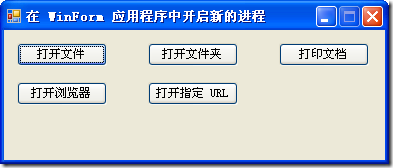WinForm 应用程序中开启新的进程及控制
2014-03-12 15:29
274 查看
在 Winform 里有时会需要打开另一个应用程序或文件,比如打开浏览器、打开word文档、打开文件夹和打印文件等等。本文介绍用 C# 在 Winform 中打开一个新进程,完成上述功能。
using System.Diagnostics
该命名空间提供与系统进程、事件日志、性能计数器的交互。其中与进程相关的两个基本类是 System.Diagnostics.Process 和 System.Diagnostics.ProcessStartInfo
System.Diagnostics.Procss:提供对本地和远程进程的访问,并使您能够启动和停止本地系统进程.
(1) Start ():启动进程,主要有如下参数设置
Start( ProcessStartInfo )
Start( string FileName )
Start( string FileName, string Arguments )
(2) 属性:
Id:唯一进程标识号
ProcessName:进程名称
MachineName:进程运行所在的计算机名
StartInfo:进程的 StartInfo
StartTime:启动进程的时间
ExitTime:退出进程的时间
HasExited:进程是否已经终止
System.Diagnostics.ProcessStartInfo:与 Process 一起使用,为 Process 设置启动参数
(1) 构造方法:
ProcessStartInfo ()
ProcessStartInfo ( string FileName )
ProcessStartInfo ( string FileName, string Arguments)
(2) 一些属性:
FileName:应用程序或文件名
Arguments:参数
WorkingDirectory:启动进程的初始目录
CreateNoWindow:是否在新窗口启动进程
WindowStyle:指定打开窗口时的状态(枚举值)
Verb:打开进程时需要使用的谓词;每个文件扩展名都有它自己的一组谓词;可以使用 Verbs 属性获取这些谓词。例如,“print”谓词将打印使用 FileName
指定的文档。可使用空字符串 ("") 指定默认谓词。
下面用一个 WinForm 小程序来简单实现打开进程:

首先,引入命名空间: using System.Diagnostics;
(1) 打开文件
(2) 打开浏览器
(2) 打开指定 URL
(2) 打开文件夹
(2) 打印文档
using System.Diagnostics
该命名空间提供与系统进程、事件日志、性能计数器的交互。其中与进程相关的两个基本类是 System.Diagnostics.Process 和 System.Diagnostics.ProcessStartInfo
System.Diagnostics.Procss:提供对本地和远程进程的访问,并使您能够启动和停止本地系统进程.
(1) Start ():启动进程,主要有如下参数设置
Start( ProcessStartInfo )
Start( string FileName )
Start( string FileName, string Arguments )
(2) 属性:
Id:唯一进程标识号
ProcessName:进程名称
MachineName:进程运行所在的计算机名
StartInfo:进程的 StartInfo
StartTime:启动进程的时间
ExitTime:退出进程的时间
HasExited:进程是否已经终止
System.Diagnostics.ProcessStartInfo:与 Process 一起使用,为 Process 设置启动参数
(1) 构造方法:
ProcessStartInfo ()
ProcessStartInfo ( string FileName )
ProcessStartInfo ( string FileName, string Arguments)
(2) 一些属性:
FileName:应用程序或文件名
Arguments:参数
WorkingDirectory:启动进程的初始目录
CreateNoWindow:是否在新窗口启动进程
WindowStyle:指定打开窗口时的状态(枚举值)
Verb:打开进程时需要使用的谓词;每个文件扩展名都有它自己的一组谓词;可以使用 Verbs 属性获取这些谓词。例如,“print”谓词将打印使用 FileName
指定的文档。可使用空字符串 ("") 指定默认谓词。
下面用一个 WinForm 小程序来简单实现打开进程:

首先,引入命名空间: using System.Diagnostics;
(1) 打开文件
private void btnOpenFile_Click(object sender, EventArgs e) { // 定义一个 ProcessStartInfo 实例 ProcessStartInfo psi = new ProcessStartInfo(); // 设置启动进程的初始目录 psi.WorkingDirectory = Application.StartupPath; // 设置启动进程的应用程序或文档名 psi.FileName = @"xwy20110619.txt"; // 设置启动进程的参数 psi.Arguments = ""; //启动由包含进程启动信息的进程资源 try { Process.Start(psi); } catch (System.ComponentModel.Win32Exception ex) { MessageBox.Show(ex.Message); return; } }
(2) 打开浏览器
private void btnOpenIE_Click(object sender, EventArgs e) { // 启动IE进程 Process.Start("IExplore.exe"); }
(2) 打开指定 URL
private void btnOpenUrl_Click(object sender, EventArgs e) { // 方法一 // 启动带参数的IE进程 Process.Start("IExplore.exe", "http://www.cnblogs.com/SkySoot/"); // 方法二 // 定义一个ProcessStartInfo实例 ProcessStartInfo startInfo = new ProcessStartInfo("IExplore.exe"); // 设置进程参数 startInfo.Arguments = "http://www.cnblogs.com/SkySoot/"; // 并且使进程界面最小化 startInfo.WindowStyle = ProcessWindowStyle.Minimized; // 启动进程 Process.Start(startInfo); }
(2) 打开文件夹
private void btnOpenFolder_Click(object sender, EventArgs e) { // 获取“收藏夹”文件路径 string myFavoritesPath = System.Environment.GetFolderPath(Environment.SpecialFolder.Favorites); // 启动进程 System.Diagnostics.Process.Start(myFavoritesPath); }
(2) 打印文档
private void btnPrintDoc_Click(object sender, EventArgs e) { // 定义一个进程实例 Process myProcess = new Process(); try { // 设置进程的参数 string myDocumentsPath = Environment.GetFolderPath(Environment.SpecialFolder.Personal); myProcess.StartInfo.FileName = myDocumentsPath + "\\TxtForTest.txt"; myProcess.StartInfo.Verb = "Print"; // 显示txt文件的所有谓词: Open,Print,PrintTo foreach (string v in myProcess.StartInfo.Verbs) { MessageBox.Show(v); } // 是否在新窗口中启动该进程的值 myProcess.StartInfo.CreateNoWindow = true; // 启动进程 myProcess.Start(); } catch (Win32Exception ex) { if (ex.NativeErrorCode == 1) { MessageBox.Show(ex.Message + " Check the path." + myProcess.StartInfo.FileName); } else if (ex.NativeErrorCode == 2) { MessageBox.Show(ex.Message + " You do not have permission to print this file."); } }
相关文章推荐
- WinForm 应用程序中开启新的进程及控制
- WinForm 应用程序中开启新的进程及控制
- WinForm 应用程序中开启新的进程及控制
- WinForm 应用程序中开启新的进程及控制
- 控制window系统应用程序定时关闭和开启
- WinForm+C#代码实现控制应用程序自启动功能
- 进程控制3 守护进程 华清远见-《嵌入式 Linux 应用程序开发标准教程》
- 在linux或者unix操作系统中在系统的引导的时候会开启很多服务,这些服务就叫做守护进程。守护进程是在后台运行不与任何控制终端关联,是Linux中的后台服务进程。它是一个生存期较长的进程,通常独立于
- 再谈应用程序单例运行(只能开启一个进程)
- C#.NET WINFORM应用程序中控制应用程序只启动一次
- 实现单进程(Single Instance)的.NET WinForm应用程序
- winform程序不能同时开启两个应用程序的判断以及捕获全局未处理异常
- 实现单进程(Single Instance)的.NET WinForm应用程序
- C# WinForm 应用程序 开启Console窗口
- WinForm 应用程序禁止多个进程运行
- WinForm 应用程序禁止多个进程运行
- linux应用程序设计(一)——文件、时间编程及进程控制
- 通过gpio控制一个进程开启或关闭
- Winform and WPF 第二遍双击快捷方式或应用程序打开原来的应用程序而不新建一个实例[进程通信 1]
- linux 进程控制1 获得当前进程的进程ID和其父进程ID 华清远见-《嵌入式 Linux 应用程序开发标准教程》
